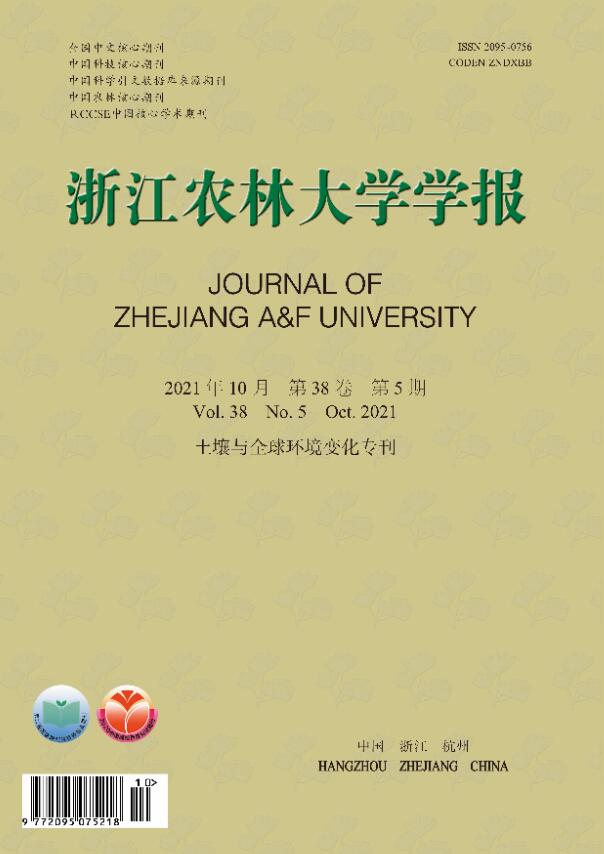-
微塑料(MPs)是指环境中粒径小于5 mm的塑料(包括碎片、纤维、颗粒、发泡、薄膜等)[1]。初级微塑料(生产于化妆品和各种工业)和次级微塑料(各种大塑料分解破碎产生)均普遍存在[2]。近年来,农田生态系统中的微塑料污染及其生态效应问题引起了全世界的广泛关注[3-4]。全球每年土壤中输入的微塑料数量远超海洋,陆地生态系统中微塑料的输入量是海洋输入量的4~23倍[5],而农田土壤输入的微塑料更多[6]。据估计,欧洲和北美洲每年通过污泥输入到农田土壤中的微塑料分别高达63 000~430 000和44 000~300 000 t·a−1[7]。ZHANG等[8]从中国云南地区的50个农田土壤样品中提取塑料颗粒(10.00~0.05 mm),塑料颗粒的丰度为7 100~42 960个·kg−1,95%的塑料颗粒粒径为1.00~0.05 mm。对杭州湾周边设施农田土壤中的微塑料调查发现:覆膜农田土壤中微塑料达20~1 560个·kg−1,包括聚乙烯薄膜、聚丙烯碎片和聚酯纤维类等[9]。土壤中微塑料来源复杂、积累量大。塑料地膜覆盖是一种全球性农业技术,它在保温、保水、保肥及土壤改良中具有很好的效果[10]。HE等[11]调查发现:上海郊区20个菜地和农田土壤中微塑料丰度分别为(78.00±12.91)和(62.50±12.97)个·kg−1,大多数微塑料为聚丙烯(50.51%)和聚乙烯(43.43%),表明土壤微塑料污染主要来源于农田地膜。近年来,全球的塑料薄膜覆盖面积迅速增加,中国是使用塑料地膜的主要国家之一,2006年,中国的塑料地膜使用面积已占全球地膜覆盖率的80%,每年近70万t低密度聚乙烯地膜投入使用[12],但农田地膜回收率却不足60%[13]。对杭州湾周边农田土壤的调查发现:设施农田土壤中微塑料的平均丰度是一般农田土壤的2倍以上[14]。除了农用地膜残留导致土壤微塑料污染外,污泥农用、大气沉降也是农田土壤中微塑料的重要来源。污泥中含有大量的合成纤维微塑料,可达1 000~4 000个·kg−1[15];根据中国污泥总产量,预计通过污泥进入土壤的微塑料可达1.56×1014个·a−1[16]。而大气中微塑料的沉降通量可达1.46×105个·m−2·a−1, 其中纤维类占95%[17]。但微塑料进入土壤后的生态效应研究目前还相对较少[18]。本研究对微塑料相关研究进行系统梳理,综合分析微塑料进入土壤后对物理环境、土壤微生物或酶、土壤动植物等的影响,探讨微塑料污染对土壤生态系统的综合效应,并为系统开展土壤微塑料的生态风险评估提出科学展望。
HTML
-
微塑料在土壤中降解非常缓慢,可能达上百年之久[19],并作为土壤的外来组分改变土壤物理特性[20]。通过向肥沃的砂土中添加微塑料后显示:培养5周后,4种不同暴露量(最高达2%)的常见微塑料(聚丙烯纤维、聚酰胺微珠、聚酯纤维和聚乙烯碎片)均能显著降低土壤容重,改变土壤结构和水分动态,并且聚酯纤维对土壤理化性质的影响最为明显,随着聚酯纤维含量的增加,土壤持水量也相应增加[21]。与此类似,壤质砂土中添加聚乙烯、对苯二甲酸聚酯、聚丙烯和聚苯乙烯等微塑料,土壤容重降低,但根际土壤容重、持水量均增加[3]。但ZHANG等[22]通过田间和盆栽试验均表明:添加质量分数为0.3%的聚酯微纤维对土壤容重没有明显改变。因此,微塑料对土壤容重的影响可能与微塑料类型、丰度等多种因素有关,也与土壤本身的性质以及是否种植植物有关。
微塑料进入土壤后,通过改变土壤水分运移影响土壤的持水性能。例如,土壤中添加1%暴露量的聚乙烯微塑料薄膜(2 mm)可显著提高土壤水分蒸发速率,因而有可能加剧土壤水分短缺[23]。微塑料也可能对土壤孔隙度有直接影响。如聚酯微纤维显著降低了土壤孔隙度<30 μm的孔隙体积,而增加>30 μm的孔隙体积,由于持水能力与小孔隙体积呈正相关,因此,超细聚酯纤维的进入降低了土壤的持水能力[22]。
-
土壤团聚体是土壤结构体的重要组成部分,也是提供土壤生物生长的重要物理条件。微塑料对土壤团聚体组成的影响程度与微塑料类型、粒径大小以及土壤中是否存在植物都有密切关系。一般土壤中,水稳性团聚体的比例会随着聚酰胺微珠、聚酯纤维和聚丙烯纤维含量增加而呈显著降低趋势[21],但在根际区域,加入微塑料反而呈较高比例的水稳性团聚体,这可能与微塑料和植物根系存在交互作用有关[3]。土壤中加入可生物降解聚乳酸、高密度聚乙烯和微塑料合成纤维等不同类型的微塑料,其水稳性团聚体及团聚体的粒径分布均有显著改变,并进而影响土壤的可侵蚀性[24]。微塑料对土壤水稳性团聚体的影响也可能是通过影响微生物生长而间接作用的。有研究表明:土壤中添加暴露量为0.4%的聚丙烯酸纤维微塑料后,土壤腐生真菌的活性增加,从而促进了水稳性团聚体的形成[25]。
1.1. 微塑料对土壤容重和持水性能的影响
1.2. 微塑料对土壤团聚体组成的影响
-
土壤动物在土壤生态系统中发挥关键作用,影响生物多样性维持、凋落物分解、养分循环和能量转移。微塑料与土壤动物的相互作用,一方面会改变土壤孔隙度、有机物含量等;另一方面,土壤微塑料也可通过土壤动物的运动发生纵向迁移,使微塑料进入深层土壤。如土壤中的蚯蚓Lumbricus terrestris暴露于一定暴露量的微塑料后,会产生更致密的蚯蚓洞穴,并将微塑料转运至洞穴中保存[26]。蚯蚓通过摄食、皮肤黏液的黏附等方式将微塑料从土壤表层搬运至深层[27]。微型节肢动物也会搬运土壤中的微塑料,并且不同的微型节肢动物对微塑料搬运的距离显著不同[28]。土壤表层的微塑料不仅可以通过节肢动物进入到土壤孔隙,还参与地下食物网的转运。ZHU等[29]研究表明:微型节肢动物利用其体积小的特点,将土壤微塑料搬运至土壤孔隙中,并进一步在跳虫Folsomia candida—螨Hypoaspis aculeifer的食物链中进行转运,利用这一食物链内的捕食关系,可以使节肢动物对土壤微塑料的搬运量增加40%。此外,微生物也可以成为微塑料迁移的载体。如真菌菌丝可以作为微塑料在小范围内转运的载体[30]。当微塑料进入土壤孔隙或地下水时,它们就更容易迁移至更深层土壤,或与植物根系和其他生物发生相互作用[26]。
-
微塑料可被蚯蚓、蚜虫Aphidoidea、线虫Aschelminthes等土壤动物摄食进入体内,并产生效应。蚯蚓排泄物中发现微塑料的存在,表明微塑料可被蚯蚓摄入体内[31]。土壤中的短纤维(12.00~2.87 mm)也可被土壤无脊椎动物摄食,这也为微塑料通过土壤无脊椎动物摄食进入陆地食物网提供了证据[32]。蚯蚓对微塑料的摄食有粒径选择性。研究发现:蚓粪中90%的聚乙烯微塑料粒径小于50 µm,而摄入的聚乙烯颗粒有50%的粒径大于50 µm,这表明小颗粒微塑料优先被蚯蚓摄食[33]。CHEN等[34]研究也发现:蚯蚓粪中微塑料的粒径分布与摄入时的微塑料粒径相比有明显变化,蚓粪中小粒径的微塑料比例更高。土壤动物摄入微塑料后,其生长受到影响。如供试土壤中添加一定量的微塑料进行蚯蚓培养时,蚯蚓的生物量降低,尤其受高密度聚乙烯微塑料暴露时,蚯蚓生物量下降最为严重[24]。当聚乙烯微塑料(粒径<150 µm)的暴露量达到一定阈值时,蚯蚓的生长速度和死亡率也受到显著影响[33]。当聚乙烯微塑料暴露量达0.1%时,跳虫生长和生殖会受到聚乙烯微塑料的抑制,当暴露量上升至1.0%时,生殖率降低70.2%[35]。不同类型的微塑料对土壤动物的影响也不同,土壤蠕虫Lobella sokamensis在受尼龙微塑料暴露后繁殖率下降程度要比聚氯乙烯微塑料暴露更大[36]。除了生长和繁殖受影响外,土壤动物的运动轨迹也可以作为微塑料暴露的评价指标,如低质量分数(8 mg·kg−1)聚苯乙烯微塑料暴露就会影响土壤跳虫的运动轨迹[37]。此外,土壤中微塑料的“载体效应”也可能使其富集农田环境中的农药而影响蚯蚓等土壤动物的生存[38]。
-
土壤动物对微塑料暴露呈现不同的应激效应。如大于1.0 g·kg−1的低密度聚乙烯微塑料暴露引起蚯蚓表面损伤、诱导氧化应激,并刺激神经毒性反应[34]。蚯蚓肠内积累聚苯乙烯微塑料后,损伤蚯蚓肠细胞,并增加了谷胱甘肽水平,抑制超氧化物歧化酶活性[39]。高暴露量(20%)的聚乙烯(≤300 µm)或聚苯乙烯(≤250 µm)颗粒显著增加了蚯蚓体内过氧化氢酶、过氧化物酶活性和脂质过氧化水平,显著抑制了超氧化物歧化酶和谷胱甘肽S-转移酶的活性;且过氧化物酶活性随微塑料暴露量的增加而增加,但其他酶活性在≤10%的暴露量下没有显著影响[31]。
肠道微生物对土壤动物的健康、代谢和免疫具有关键作用,微塑料暴露会改变土壤动物肠道微生物的组成[40]。跳虫在暴露聚氯乙烯微塑料后,其新陈代谢和碳氮吸收受干扰,肠道微生物群落中细菌多样性增加[41]。但也有研究表明:0.5%的聚乙烯微塑料暴露量会显著降低跳虫肠道细菌多样性[35]。另一方面,土壤动物的肠道微生物也可参与微塑料的降解。从广州、泰安和深圳等地采集的粉虫Tenebrio molitor均可以利用肠道微生物将聚苯乙烯、聚氯乙烯、低密度聚苯乙烯微塑料降解,并且不同地区的粉虫由于其体内肠道微生物的差异,对微塑料的代谢能力也不同[42]。
-
土壤中微塑料可能通过陆地生态系统的食物链在不同动物体中传递、积累并产生效应[43]。土壤中微塑料可以在库蚊Culex pipiens的幼虫、蛹和成虫中积累,积累量受到初始暴露量的显著影响[44];但幽蚊Chaoborus flavicans在微塑料暴露量较高时,依然能够产卵[45]。LWANGA等[46]以墨西哥东南部的热带家庭花园为例,发现土壤、蚯蚓、鸡Gallus gallus domesticus粪中的微塑料依次递增,这表明微塑料可以在土壤—蚯蚓—鸡这条食物链中传递、积累和放大。在上海某地收集的陆生死亡鸟类消化道中发现的微塑料粒径要远远小于这些鸟类的食物粒径,由于鸟类的觅食行为具有多样化,由此推测鸟类摄入微塑料可能是通过食物链传递的结果[47-48]。
微塑料在陆生动物体内的积累影响其生长与繁殖。环境质量分数(0.71 g·kg−1)下对苯二甲酸乙二醇酯(PET)微塑料纤维可显著减少蜗牛Achatina fulica取食和排泄,引起氧化应激反应,降低还原型谷胱甘肽过氧化物酶和总抗氧化能力[49]。聚乙烯微塑料会影响小鼠肠道微生物的组成和多样性,当浓度达到一定水平时会引起小鼠小肠炎症[50]。聚苯乙烯微塑料可在小鼠肠道内积累,减少小鼠肠道黏液分泌,损害肠屏障功能,诱导小鼠肠道微生物区系失调和代谢紊乱[51],并诱发肝脏脂质紊乱[52]。聚苯乙烯微塑料对雄性小鼠生殖系统也有影响,导致精子数量、活力显著下降,精子畸形率显著提高和精子代谢相关的酶活性下降[53]。而母体小鼠在妊娠期和哺乳期暴露于聚苯乙烯微塑料下,微塑料可以导致母体肠道菌群紊乱和代谢失调,还有代际效益,对后代造成长期代谢后果[54]。但也有研究表明:通过聚丙烯喂养鸟类,对鸟类的死亡率、发病率、生育能力等并没有明显影响,只发现雄性鸟类生殖囊肿频率增加,雏鸟生长和性成熟的轻微延迟等现象[55]。
2.1. 土壤动物影响下的微塑料转运与迁移
2.2. 土壤动物对微塑料的摄食
2.3. 土壤动物及其肠道微生物对微塑料暴露的效应
2.4. 陆生动物食物链中微塑料的积累与生态效应
-
土壤酶活性代表微生物群落的总体活性和微生物摄取底物的有效性,而荧光素二乙酸酯酶(FDAse)代表整个微生物代谢活动的活力,是土壤质量短期变化的有效指标[56]。例如,随着塑料薄膜暴露量的增加,邻苯二甲酸酯类含量增加,土壤微生物碳和氮含量、荧光素二乙酸酯酶和脱氢酶的活性,以及微生物群落结构多样性显著降低[57],这与塑料释放的邻苯二甲酸酯类污染物有关,它可通过破坏细胞膜的流动性影响土壤微生物活性、多样性和代谢活性。有研究利用中国黄土为供试土壤,添加微塑料观测土壤酶活性的变化,发现添加微塑料增强了荧光素二乙酸酯酶和酚氧化酶的活性[58]。低密度聚乙烯微塑料(2 000个·kg−1)碎片暴露后土壤脲酶、过氧化氢酶活性显著提高[59]。聚苯乙烯纳米塑料暴露后土壤亮氨酸氨基肽酶、碱性磷酸酶、β-葡萄糖苷酶和细胞水解酶的活性显著降低[60]。通过在酸性土壤中添加暴露量为1%和5%低密度聚乙烯和聚氯乙烯微塑料研究发现:微塑料的添加显著刺激了土壤脲酶和酸性磷酸酶活性,但降低了荧光素二乙酸酯酶活性。这些不同试验观测到的微塑料暴露对土壤酶活性影响的差异可能与土壤性质和微塑料种类及其暴露量都有关系[61]。
-
土壤微塑料对微生物群落的丰富度和多样性受土壤类型、微塑料类型、暴露量等因素影响。低密度聚乙烯微塑料碎片(2 000个·kg−1)暴露对土壤中微生物α多样性(丰富度、均匀度和多样性)没有明显影响;但微塑料碎片上微生物的多样性指数明显低于对照和微塑料添加土壤;同时在微塑性碎片上形成了一个与供试土壤明显不同的微生物区系,表现在放线菌显著富集,包括塑料降解细菌和病原体更加丰富[59]。土壤中添加5%的聚乙烯微塑料后,放线菌取代蛋白质细菌成为微塑料暴露土壤中的优势门,表明微塑料对微生物具有选择作用,改变微生物群落的多样性和丰富度[62]。研究发现:1%和5%的低密度聚乙烯和5%的聚氯乙烯显著降低了细菌群落丰富度和多样性,但显著增加了β-变形菌,其中包括与土壤固氮密切相关的伯克氏菌科Burkholderiaceae,这表明微塑料可能影响土壤中的氮素循环[9, 61]。微塑料与微生物群落组成的相互影响可能对微生物参与的地球生物化学循环存在潜在影响,其中微生物异化铁还原是最早具有全球意义的微生物呼吸过程之一。金属假单胞菌Geobacter metallireducens GS15是一种异化铁还原菌,是生物地球化学铁循环关键调节因子,研究发现聚氯乙烯微塑料对GS15以不溶性铁水化合物为末端电子受体铁循环过程表现出潜在的抑制作用。聚对苯二甲酸丁二酯微塑料和聚氯乙烯均能延迟GS15的电活性[63]。同时,微塑料也是环境微生物的新型栖息地,也被称为“塑料圈”[64-65]。微塑料表面定殖的微生物群落与周围土壤中、植物凋落物中的微生物群落具有显著差异,富集了一些具有降解塑料聚合物的微生物种群,如酸杆菌门Acidobacteria、绿弯菌门Chloroflexi、芽单胞菌门Gemmatimonadetes和拟杆菌门Bacteroidetes等[66]。
3.1. 微塑料对土壤酶活性的影响
3.2. 微塑料对微生物群落的影响
-
目前关于植物吸收微塑料的相关研究极其缺乏。通过水培试验发现:小麦Triticum aestivum种子在萌发时会吸收纳米聚苯乙烯(100 nm)塑料小球并传输到根部[67],也可以在蚕豆Vicia faba根部积累,并可能阻断细胞连接或细胞壁孔运输营养物质[68]。通过土培试验也可发现:绿豆Vigna radiata可以吸收纳米塑料聚苯乙烯,并积累在叶片中[69]。对于更大粒径的亚微米级和微米级微塑料的植物吸收,目前的相关报道更少。李连祯等[70]利用荧光标记和扫描电镜观测,发现水培试验中的粒径为0.2 μm的聚苯乙烯微塑料小球不仅可在生菜Lactuca sativa var. ramosa根部大量富集, 并可被进一步转运至茎叶等可食部位积累。最近,又通过土培试验进一步证实:粒径为0.2和2.0 μm的聚苯乙烯塑料小球可以通过小麦和生菜侧根位置的裂隙进入植物体内部,并随蒸腾作用从根部转运到地上部[71]。
-
微塑料对植物生长的影响既有抑制也有促进作用。有研究把6种常见微塑料加入土壤混合进行洋葱Allium fistulosum培养试验后发现:微塑料添加对洋葱的叶片性状、总生物量、元素组成、根系性状等均有显著影响[3]。添加1%的微塑料对小麦的地上部分和地下部分生长均有影响,并且可生物降解的微塑料比低密度聚乙烯微塑料表现出更强的抑制效果[72]。纤维或可生物降解的聚乳酸微塑料会抑制黑麦草Lolium multiflorum种子的发芽率,聚乳酸微塑料还会导致芽长降低。但与聚乳酸微塑料的影响不同,高密度聚乙烯却发现能增加根系生物量[24]。此外也发现地膜残留物会长期影响陆地棉Gossypium hirsutum产量[73]。微塑料对植物生长的影响也表现在一些植物生理指标上。如阻碍生菜的光合作用、干扰其抗氧化防御系统等[74]。蚕豆在10~100 mg·L−1的聚苯乙烯微塑料暴露下,过氧化氢酶活性降低,超氧化物歧化酶和过氧化物酶活性显著升高,表现氧化应激反应;当微塑料粒径减小至纳米级时,进一步表现出遗传毒性和氧化损伤毒性[68]。
微塑料对植物的促进作用最近也有报道。如添加0.4%的聚酯纤维微塑料增加了植物群落根、茎的质量,提高植物群落的生物量,可能是土壤中的微塑料降低了土壤容重,增加了土壤大孔隙比例,改善了土壤通气性和渗透性,从而改善了植物生长环境[75]。同时,研究也发现:不同种类植物生长受微塑料的影响不同,最终会体现在植物群落结构组成上的差异,减少植物群落的多样性[75]。
-
植物根际环境中微塑料污染的效应研究非常有限。微塑料对根际环境的效应是土壤物理化学性质、根系分泌物与根际微生物之间相互作用的结果[76]。植物根系也是微塑料向土壤内部迁移的动力之一,因此,微塑料可能在根际环境中富集并对根际环境产生影响[30]。当小麦根系暴露在1%低密度聚乙烯微塑料时,根际的细菌群落与对照相比有显著差异,说明土壤中微塑料污染对小麦根际环境中细菌群落的组成有显著影响[77]。微塑料与一般的化学污染物质不同,它是一种物理颗粒,对土壤生态系统的效应可能是通过影响土壤物理化学性质[77]、养分转化[58, 78-79]、污染物质释放[80]等,并进而影响土壤微生物组成与功能多样性等综合作用的结果。
4.1. 植物对微塑料的吸收
4.2. 微塑料对植物生长的影响
4.3. 植物根际环境中的微塑料效应
-
土壤微塑料污染的生态效应研究才刚起步,相关的基础数据积累少,还无法认识微塑料对不同生物体的效应机制。目前的研究存在如下问题:①相关研究中还存在暴露量与实际环境浓度相差较大、剂量-效应关系不确定、供试土壤性质单一等突出问题;②微塑料的生态效应不仅受暴露量的影响,也受到其粒径大小、形状、聚合物类型等因素共同作用,目前许多研究仅仅考虑暴露量的效应而忽视了其他性质的作用,导致研究结果之间缺乏可比性;③微塑料含有多种添加剂,并会在土壤中富集农药、抗生素、抗性基因等污染物质,在一定条件下,这些添加剂和污染物质会重新释放到土壤或生物体中,影响土壤生态系统。因此,开展土壤微塑料污染的生态效应研究,必须在认识环境微塑料的粒径、化学、结构、表面等基本特性基础上,围绕土壤生态安全相关的生物受体,从多学科角度开展系统研究,具体包括以下几个方面:①加强土壤微塑料污染生态效应方法学的研究,筛选模式生物与敏感的生物标志物,探究环境暴露剂量下,不同性质微塑料的生物作用机制与效应,建立土壤微塑料污染的生态风险评估方法体系;②加强土壤微塑料及其负载污染物对物质转化关键功能微生物的影响研究,阐明土壤微塑料与养分元素、重金属、有机污染物之间相互作用的微生物学机制;③加强研究土壤微塑料及其负载污染物质的植物吸收、转运及在植物体内的积累机制,探讨植物根际环境中微塑料与根系分泌物、微生物、养分元素之间的相互作用机制,明确土壤微塑料污染的植物反馈机制;④加强微塑料及其负载污染物在地下食物网系统的传递、积累机制研究,探明微塑料及其负载污染物在不同营养层生物间的传递、转化与生物富集过程,揭示土壤微塑料污染的地下—地上生物联动效应及其机制;⑤加强土壤“塑料圈”研究,探究不同类型土壤生态系统条件下微塑料表面生物膜和微生物组成与功能特征,及其对土壤中微塑料降解、污染物和养分转化的作用机制。









 DownLoad:
DownLoad: